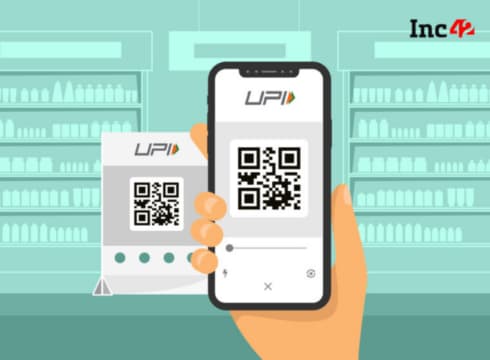All the support money provided by the government has been appropriated by banks only, while payment aggregators have received nothing: Vishwas Patel
The PCI chairman also called for increasing the total compensation from government for promoting low-value UPI and RuPay debit card transactions to INR 8,000 Cr
Patel also questioned the need to compensate big merchants like Amazon and Flipkart, and said digital transactions for only small merchants should be subsidised
Inc42 Daily Brief
Stay Ahead With Daily News & Analysis on India’s Tech & Startup Economy
Payments Council of India (PCI) Chairman Vishwas Patel has claimed that the banks appropriated all the monetary support provided by the Centre to compensate for zero-charge levy on UPI transactions.
“…all the support money provided by the finance ministry has been appropriated by the banks only (no single bank has even a significant single digit volume in UPI)… none of the payment aggregators (PAs) or facility provider(s) received anything,” Patel, who is also the executive director of fintech firm Infibeam Avenues, said in a tweet.
He was responding to the Ministry of Finance’s clarification on Twitter that there are no plans to levy any charges for UPI services.
“Most of the UPI payments are driven by PAs and when the government granted subsidies of INR 1,500 Cr, the banks only kept it for themselves. They are not passing it onto the payment aggregators,” Patel told Inc42.
It must be noted that PhonePe, Google Pay and Paytm hold sway over the UPI market, and accounted for 95% of the total market share in July 2022.
Unlike other digital transactions, zero merchant discount rate (MDR) is levied on UPI and RuPay debit card transactions.
To compensate for this, the government allocated INR 1,500 Cr for the promotion of digital payments in the Budget for financial year 2021-22 (FY22). Subsequently, in December 2021, the Union Cabinet approved an INR 1,300 Cr scheme to incentivise low-value transactions through RuPay debit card and BHIM UPI.
These funds were used to typically reimburse players for transactions below INR 2,000 value.
The government also set aside INR 200 Cr for promoting digital payments in the Budget for FY23.
However, there have been calls from the industry to levy charges on UPI transactions to promote investments in the space.
A row erupted after the Reserve Bank of India (RBI), in a discussion paper, sought feedback from the general public on whether it should levy charges on UPI transactions. The aftermath saw public outcry and later, the Finance Ministry issued the clarification.
Over the years, UPI payments have gained immense popularity in the country. The National Payments Corporation of India (NPCI) processed 628 Cr transactions worth INR 10.63 Lakh Cr in July this year.
Govt Should Provide INR 8,000 Cr Compensation Annually
Patel told Inc42 that the government’s allocation of INR 1,500 Cr is ‘too less’ and pegged the required annual compensation at around INR 6,000 Cr for UPI transactions and INR 2,000 Cr for RuPay payments.
The PCI wrote to the central government last month, urging it to increase the subsidy outlay to INR 8,000 Cr yearly, he said.
“Payment aggregators have spent nearly INR 25,000 Cr over the last five years to grow the UPI acceptance base, change consumer behaviour and to encourage users to transact more. Payment aggregators have done the most hard work and we are not getting anything,” Patel added.
According to the PCI’s data, the cumulative loss of 13 major PAs, including Billdesk, PayU and RazorPay, during FY16-FY21 period stood at INR 24,359 Cr.
Patel pointed out that in the absence of banks passing on the compensation for zero MDR regime to the PAs, the fintech players are reeling under heavy costs.
“Since UPI also contributes to overall transaction volumes, how do fintech players comply with the RBI’s payment aggregators and payment gateway licence requirements of positive net worth?” the PCI chairman asked.
Subsidise Only Small Merchants
In conversation with Inc42, Patel also took potshots at the government and large ecommerce players over the MDR compensation regime. He said that the Centre should only subsidise UPI and RuPay debit card transactions for smaller merchants.
“Why is taxpayers’ money being used to subsidise transactions of big merchants such as Amazon and Flipkart?…If big merchants are paying RBI’s prescribed MDR on Mastercard debit cards and Visa debit cards, then why should the government use taxpayers’ money to subsidise UPI and RuPay transactions for medium to large merchants,” he said.
Currently, Visa and Mastercard debit cards attract MDR in the range of 0.4% to 0.9%.
Responding to a question, Patel also said that payment aggregators were willing to spend crores of rupees previously, but the purported ‘funding winter’ enveloping the fintech industry has led to a cash crunch with companies saving every penny.
“Funding in the fintech sector is also drying up. How can we keep the UPI growth going considering the growing infrastructure costs?” he questioned.
{{#name}}{{name}}{{/name}}{{^name}}-{{/name}}
{{#description}}{{description}}...{{/description}}{{^description}}-{{/description}}
Note: We at Inc42 take our ethics very seriously. More information about it can be found here.


